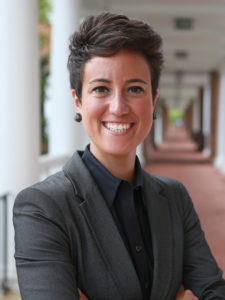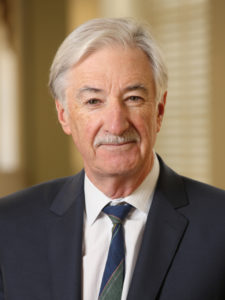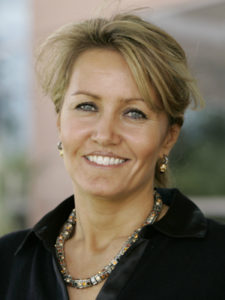
From Brands Taking Stands to Tech Changing Retail: 5 Big Trends in Marketing Today
By Dave Hendrick
As attention spans shrink, platforms evolve or dissolve and data drives an increasingly personalized consumer experience, the role of the marketer is evolving at a clip.
The evolution comes with new opportunities, particularly within organizations where traditional silos have fallen or become scrambled and cross-discipline expertise is increasingly valued, according to University of Virginia Darden School of Business student Lauren Hansen (Class of 2018), president of the 250-member Marketing Club at Darden.
Hansen, who will start an associate brand manager position with Johnson & Johnson after graduation, suggested the general management tenets of the core curriculum provided a critical foundation for the marketer interested in being a catalyst for business growth.
“It’s very much the role of the brand manager to drive growth and figure out what is the innovation pipeline and what is the strategy that’s going to authentically connect in a unique way,” Hansen said. “In that sense, Darden is a marketing school because it’s training us to learn how all of these different disciplines work together, and that’s so crucial when you think about motivating cross-functional teams and getting people to buy the vision and deliver on a brand promise.”
Hansen, who has taken courses with more than half of the marketing faculty during her two years at the School, said the curriculum offered a healthy mix of “classic cases” to ground students in marketing fundamentals, cases addressing the new suite of challenges and technological opportunities facing the modern marketer and experiential opportunities to practically implement the instruction.
According to Hansen, it’s an energizing time to be working to connect consumers with products.
“It’s a fascinating landscape right now, because while brands have always had to earn trust, now it’s exciting to think about a more holistic relationship with a consumer and more holistic consumer experience,” Hansen said. “It’s about connecting to this broader emotional need, where brands are being challenged to really take a stand on matters that wouldn’t be required or demanded previously.”
What else is fascinating and exciting about marketing right now?
In their own words, here’s what Darden faculty are keeping their eyes on in the rapidly changing sector:
Retail Shakeup: Technology Redefining the Retail Experience
 There are several interesting trends in marketing right now. One is the retail shakeup as technology interrupts the classic retail experience and e-commerce grows as an essential part of consumers’ lives. As consumers expect status quo to be convenient online search with access to a variety of options at low prices (yet provided with personalized service), and quick purchase and delivery, retail marketers are trying to co-opt some of the e-commerce features. The competition is fierce and only those that can lean into the change will survive.
There are several interesting trends in marketing right now. One is the retail shakeup as technology interrupts the classic retail experience and e-commerce grows as an essential part of consumers’ lives. As consumers expect status quo to be convenient online search with access to a variety of options at low prices (yet provided with personalized service), and quick purchase and delivery, retail marketers are trying to co-opt some of the e-commerce features. The competition is fierce and only those that can lean into the change will survive.
Another interesting observation is that the distinctions between firms (e.g., marketing consultants vs. creative agencies vs. boutique behavioral economics consultancies) as well as between functions within firms (e.g., marketing, strategy, operations, finance) are blurring. The shift is from a focus on mechanic executions to understanding the customer and creating unique and meaningful experiences that are accessible yet still profitable. — Professor Lalin Anik
Sensory Marketing: Influencing Subconscious Decision-Making
 The most exciting area of marketing, in my opinion, is something called sensory marketing. The idea is that without our conscious awareness, our bodily sensations influence the decisions we make. Sensory marketing helps to understand how we can convey ideas such as quality or trust using different senses — smell, taste, vision, touch, auditory. Consumers don’t perceive sensory stimulations as marketing messages and therefore don’t react with the usual resistance to ads and other promotions. — Professor Luca Cian
The most exciting area of marketing, in my opinion, is something called sensory marketing. The idea is that without our conscious awareness, our bodily sensations influence the decisions we make. Sensory marketing helps to understand how we can convey ideas such as quality or trust using different senses — smell, taste, vision, touch, auditory. Consumers don’t perceive sensory stimulations as marketing messages and therefore don’t react with the usual resistance to ads and other promotions. — Professor Luca Cian
Channels of Distribution and Communications are Evolving, Merging and Multiplying
 Marketers are learning how to redesign and coordinate their branding and go-to-market strategies to match how customers want to buy. What marketers call “omni-channel” marketing is not only for retailers, but also upstream marketers. Changing distribution strategy has historically been one of the most difficult challenges that business faced, but for many marketers it is not a question of if, but how and when to adapt, which metrics they will choose to monitor success, and how long the transition will take; if, indeed, the transition is ever complete. — Professor Paul Farris
Marketers are learning how to redesign and coordinate their branding and go-to-market strategies to match how customers want to buy. What marketers call “omni-channel” marketing is not only for retailers, but also upstream marketers. Changing distribution strategy has historically been one of the most difficult challenges that business faced, but for many marketers it is not a question of if, but how and when to adapt, which metrics they will choose to monitor success, and how long the transition will take; if, indeed, the transition is ever complete. — Professor Paul Farris
What’s Not OK? Aligning Expectations in the Digital Space
 I think one of the biggest challenges currently facing business managers is understanding what consumers consider as appropriate behaviors — or ‘norms’ — in the digital space. No doubt, digital innovations have made it easier for companies to reach and interact with consumers, often in creative ways that were not possible in the offline world. Some of these features may be great ways to keep consumers engaged, but there are also a host of other features that consumers may find inappropriate. For instance, while consumers may appreciate being able to specify their preferences to receive better targeted ads, they may not find it appropriate for advertisers to purchase their personal information from other companies to produce better targeted ads for them. In other words, there often is a misalignment between consumers and companies in what they believe is an appropriate behavior, and this gap is likely going to increase as digital marketing capabilities become more refined and varied. — Professor Tami Kim
I think one of the biggest challenges currently facing business managers is understanding what consumers consider as appropriate behaviors — or ‘norms’ — in the digital space. No doubt, digital innovations have made it easier for companies to reach and interact with consumers, often in creative ways that were not possible in the offline world. Some of these features may be great ways to keep consumers engaged, but there are also a host of other features that consumers may find inappropriate. For instance, while consumers may appreciate being able to specify their preferences to receive better targeted ads, they may not find it appropriate for advertisers to purchase their personal information from other companies to produce better targeted ads for them. In other words, there often is a misalignment between consumers and companies in what they believe is an appropriate behavior, and this gap is likely going to increase as digital marketing capabilities become more refined and varied. — Professor Tami Kim
The Chief Marketing Officer Role Is Changing, Quickly
 In the 1990s, when the chief marketing officer (CMO) role was coming into vogue, the priority was on advertising, creating emotional connections with customers and building superior brands. In the 2000s, the CMO had to become finance literate as CEOs expected CMOs to demonstrate how they delivered financial impact (of note, this challenge is continuing today as it hasn’t yet been mastered). However, in the 2010s, the CMO had to add tech literacy to their repertoire as data, analytics and consumer impact (through customization) all became enabled through technology. What does this mean? The CMO role is arguably the most challenging in the C-suite, requiring CEO-type enterprise-wide knowledge. However, it is also one of the most exciting positions, and those who can become literate in building consumer-brand connections, delivering marketing-finance accountability and leveraging technology will be poised to move into CEO and board roles. — Professor Kimberly Whitler
In the 1990s, when the chief marketing officer (CMO) role was coming into vogue, the priority was on advertising, creating emotional connections with customers and building superior brands. In the 2000s, the CMO had to become finance literate as CEOs expected CMOs to demonstrate how they delivered financial impact (of note, this challenge is continuing today as it hasn’t yet been mastered). However, in the 2010s, the CMO had to add tech literacy to their repertoire as data, analytics and consumer impact (through customization) all became enabled through technology. What does this mean? The CMO role is arguably the most challenging in the C-suite, requiring CEO-type enterprise-wide knowledge. However, it is also one of the most exciting positions, and those who can become literate in building consumer-brand connections, delivering marketing-finance accountability and leveraging technology will be poised to move into CEO and board roles. — Professor Kimberly Whitler
The University of Virginia Darden School of Business prepares responsible global leaders through unparalleled transformational learning experiences. Darden’s graduate degree programs (MBA, MSBA and Ph.D.) and Executive Education & Lifelong Learning programs offered by the Darden School Foundation set the stage for a lifetime of career advancement and impact. Darden’s top-ranked faculty, renowned for teaching excellence, inspires and shapes modern business leadership worldwide through research, thought leadership and business publishing. Darden has Grounds in Charlottesville, Virginia, and the Washington, D.C., area and a global community that includes 18,000 alumni in 90 countries. Darden was established in 1955 at the University of Virginia, a top public university founded by Thomas Jefferson in 1819 in Charlottesville, Virginia.
Press Contact
Molly Mitchell
Senior Associate Director, Editorial and Media Relations
Darden School of Business
University of Virginia
MitchellM@darden.virginia.edu







